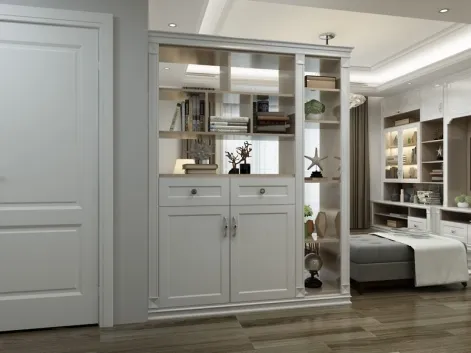Ever walked into someone's home and instantly felt that 'wow' factor? Chances are, they've mastered the art of the console cabinet. These slender, elegant pieces are the unsung heroes of interior design – hidden in plain sight yet transforming ordinary rooms into sophisticated sanctuaries.
Picture this: you're struggling with keys in your entryway when a chic console catches your mail before it hits the floor. Or you're entertaining guests in your cramped apartment, only to whip drinks from its hidden drawers. That’s the magic of interior and exterior decoration materials like console cabinets – they don't just occupy space; they elevate it.
The French Revolution in Your Living Room
17th Century Origins: Born in Louis XIV's France, console cabinets started as wall-mounted marble slabs (called "consoles") for displaying candelabras and sculptures. Unlike today’s free-standing versions, they clung to walls like elegant barnacles.
Function Meets Art: Aristocrats soon realized these pieces could be both practical and theatrical. By the 18th century, gilded legs appeared, turning them into status symbols dripping with ormolu detailing.
Beyond Pretty: Your Home's MVP
The Grand Entrance Maker
Entryways set the tone. A console here is like a concierge:
- Key catcher : Sliding tray for daily essentials
- First impression : Mirror pairing creates visual depth
- Shoe whisperer : Discreet baskets under shelves
The Living Room Illusionist
Squeezed behind your sofa? Suddenly:
- Lamps hover at eye-level without floor clutter
- Books stack vertically with decorative bookends
- Remotes disappear into hidden drawers
The Dining Room Hero
Hosting nightmares vanish when your console doubles as:
- A serving station for wine decanters
- Buffet extension during holiday feasts
- Linens storage in narrow drawers
Console vs. Counterparts
Pro Styling Secrets
The Rule of Thirds
Group decor in odd numbers: 1 tall lamp + 3 stacked books + 5 seashells in a bowl. Creates rhythm without chaos.
Material Mixology
Pair textures like matte stone tops with reflective brass legs. Add warmth with wood or drama with marble-effect finishes.
Light Layering
Flank with slender lamps (28"-32" tall). For open bases, stick LED strips underneath – instant floating effect.
Room-by-Room Transformations
Small-Space Solutions
Got a 12-foot studio? Try these:
- Behind-the-couch console: 6" clearance = surface without overcrowding
- Kitchen peninsula partner: Extra prep space near ovens
- Bedroom divider: Defines areas without walls
Office Magic
Whip a basic console into a hybrid workstation:
- Add wireless printer on lower shelf
- Thread cords through grommets
- Use chic boxes to hide office supplies
Shopping Smarts
Measure Like a Pro
Depth matters most! Hallways need 12"-15" deep consoles. Behind sofas? Max 18" to avoid knee-banging.
Material Matters
Entryways demand wipeable surfaces like sealed wood or resin. Bedrooms embrace velvety matte finishes.
Hidden Storage Wins
Drawers > shelves for hiding clutter. Depth of 4"-6" fits phones, wallets, dog leashes perfectly.
More Than Just Furniture
Console cabinets aren't just places to dump keys. They're design alchemists – turning dead wall space into functional vignettes, transforming clutter into curated displays. From their royal French roots to modern minimalist iterations, they've consistently solved the eternal design dilemma: how to be useful without yelling for attention.
The magic lies in their proportions. Standing taller than coffee tables but narrower than dressers, they navigate spatial politics with diplomatic grace. One minute they're playing bar in your dining room, the next they're a vanity in your bedroom. In open-plan homes, they act as subtle room dividers; in cramped apartments, they become optical illusions that stretch walls.
So next time you pass that empty sliver of wall, don't just see dead space. See a potential console moment waiting to happen – your home’s quiet secret weapon against ordinary.













